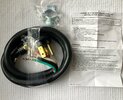Unfortunately, it doesn't work that way. You need to get a dedicated EVSE (Juicebox/HPWC). The car needs to 'communicate' to the EVSE for safety, and a piece of wire won't have that, so the car won't start charging.
Yes, you'll need to purchase Juicebox 48 Pro or Tesla Wall Connector.
If you're putting in a brand new 60A (48A continous) circuit in your garage, please consider installing a NEMA 14-60R (recepticle) instead of a 14-50R. The 14-60 outlet is rated for 60A (48A continous) and can be used with the Juicebox Pro 48 or Tesla Wall Connector to get the full 48A of current. You will just need to install a NEMA 14-60P (plug) on the EVSE. Alternatively, you can just hardwire the EVSE to your 60A circuit and forgo the receptacle altogether, but this will mean that you won't be able to unplug it and take it with you (if that matters to you). I doubt many people take their Juicebox/HWPC with them as they're large units with heavy cables.
Some options for the NEMA 14-60R (recepticle):
Leviton
Bryant
Hubbell
Eaton
Some options for the NEMA 14-60P (plug):
Leviton
Hubbell
Eaton
Lastly, you can install a 50A circuit with the NEMA 14-50R as you suggested. However, then you're limiting yourself to only 40A continous, so if I were putting a new circuit, I'd make it 60A to get the full current and to make the installation cost worth it.
That's right. Even though you're using a 14-50 plug which should in theory give 40A continous, the Tesla EVSE that comes with the car is limited to 32A, so the plug is coded to pull no more than 32A.




